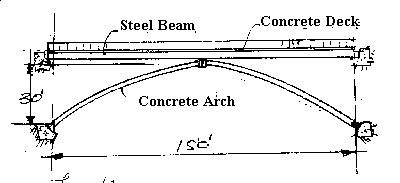EXAMPLES OF THE USE OF DESIGN PROGRAMS
1. Funicular Arch (D-FUNICU.BAS)
2. Properties of a built-up angle (PROP-XY.BAS)
(Use of the program D-FINICU.BAS}
A sketch is shown in the attached drawing. It is a concrete arch with a span of 150 feet and a rise of 30 feet. The distance from the crown to the springing is 80.78 feet. It is a pedestrian bridge and the arch supports a steel girder of 75 foot span. The arch can be precast or cast horizontal and rotated into place. It is three hinged.

The steel beam supports a 4 inch concrete deck, 12 feet wide over sheet metal decking. The weight of the steel beam is assumed to be 100 plf. The live load is assumed to be 40 psf. The arch rib is assumed to be 16x30 inches. Design the arch for optimum stresses using the program to determine the coordinates of the arch.
The reaction of the steel beam at the center support for half the span is:
